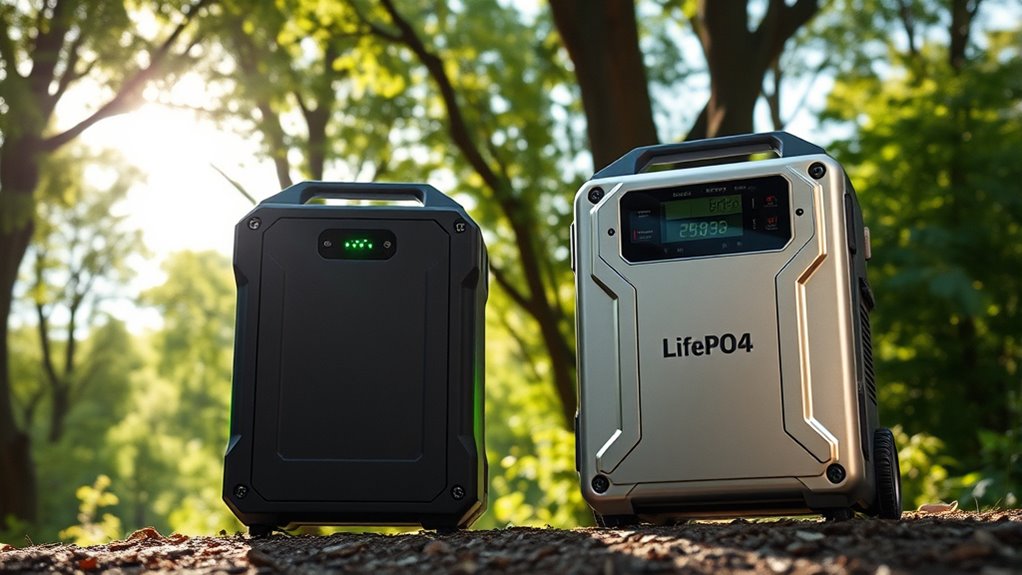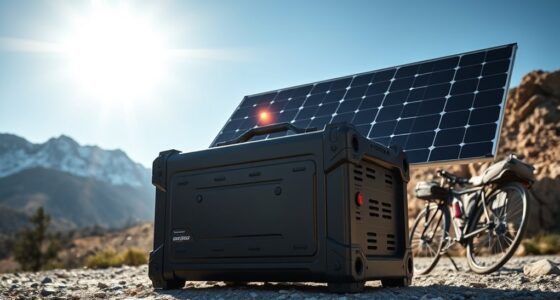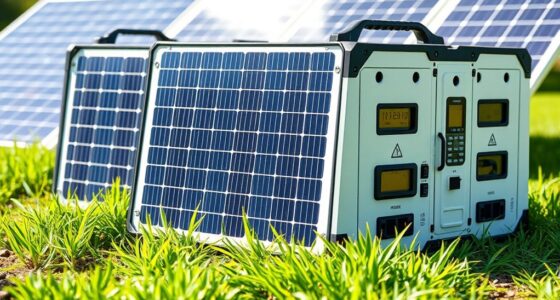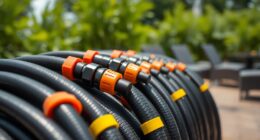If you compare LiFePO₄ and traditional lithium-ion batteries for solar generators, LiFePO₄ offers a longer lifespan, often lasting 2,000-3,000 cycles, thanks to its superior safety and thermal stability. It handles extreme temperatures better and reduces fire risks. While it may cost more upfront, its durability and eco-friendly materials make it cost-effective in the long run. To learn more about why LiFePO₄ batteries could be the smarter choice, keep exploring these key differences.
Key Takeaways
- LiFePO₄ batteries offer a longer cycle life (2,000–3,000 cycles) compared to typical lithium-ion batteries, increasing durability.
- They have superior thermal stability and safety, reducing fire risks and enhancing longevity in harsh conditions.
- LiFePO₄ batteries maintain consistent performance over time, with less capacity degradation than standard lithium-ion options.
- Despite higher initial costs, LiFePO₄ batteries lower total ownership expenses due to fewer replacements.
- Their eco-friendly materials simplify recycling, supporting sustainable use and longer system lifespan.
Understanding Battery Chemistry and Composition
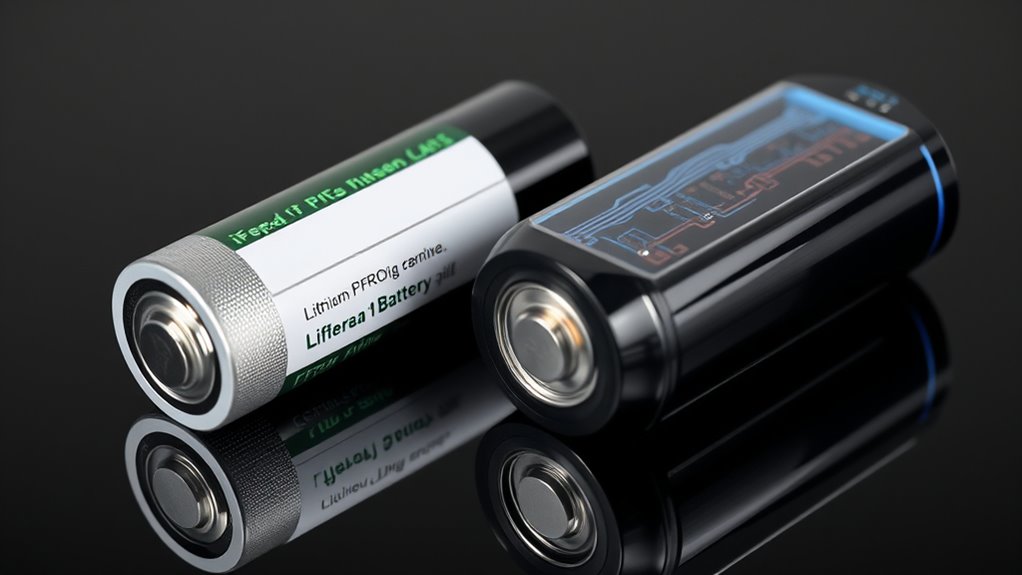
To understand the differences between LiFePO₄ and other lithium-ion batteries, you need to know their fundamental chemistry and composition. The electrolyte stability plays a key role in battery safety and performance; LiFePO₄ batteries generally have more stable electrolytes, reducing risks like thermal runaway. The cathode materials also differ markedly: LiFePO₄ uses iron phosphate, which provides a stable and environmentally friendly alternative to traditional cobalt-based cathodes. This composition results in a battery that’s less prone to overheating and degradation over time. In contrast, other lithium-ion batteries often use layered nickel, manganese, or cobalt oxides, which can offer higher energy density but may compromise stability. Understanding these core differences helps you appreciate why LiFePO₄ batteries are often favored for longevity and safety. Additionally, the battery chemistry influences how well each type can withstand repeated charging cycles, impacting overall durability.
Longevity and Cycle Life of Both Battery Types
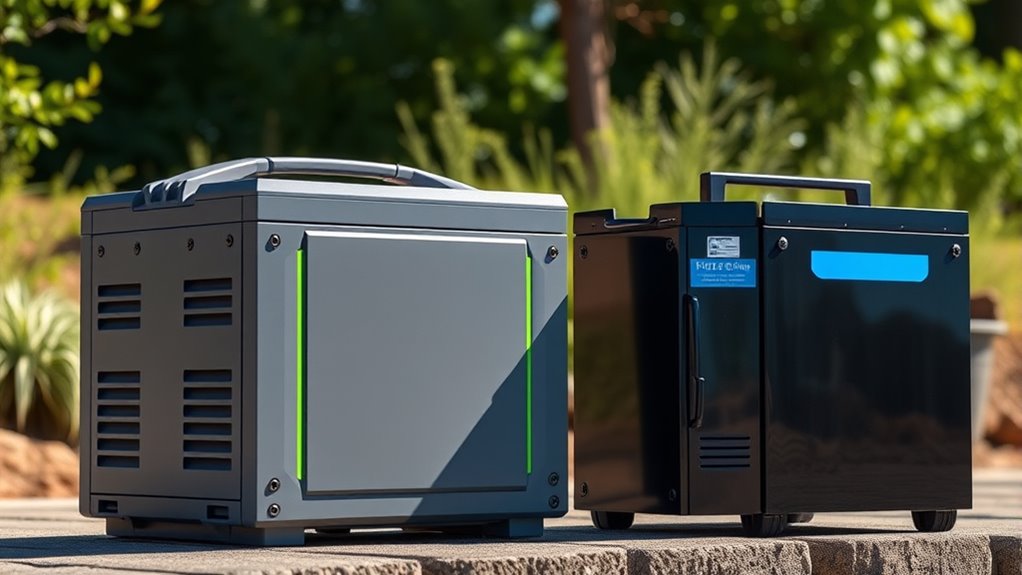
When comparing the longevity of LiFePO₄ and other lithium-ion batteries, you’ll find that LiFePO₄ typically offers a longer cycle life due to its stable chemistry. This stability reduces battery degradation over time, allowing it to maintain capacity longer and withstand more charge-discharge cycles. As a result, LiFePO₄ batteries often last 2,000 to 3,000 cycles, compared to 500 to 1,000 cycles for many lithium-ion types. Because of this durability, warranty coverage for LiFePO₄ batteries tends to be more thorough, reflecting their longer lifespan. You’ll benefit from fewer replacements and lower maintenance costs, making LiFePO₄ a more reliable choice for long-term solar energy storage. Additionally, the contrast ratio of LiFePO₄ batteries contributes to their ability to perform consistently under various conditions, further enhancing their longevity. This longevity ensures your investment remains protected over many years.
Safety Features and Thermal Stability
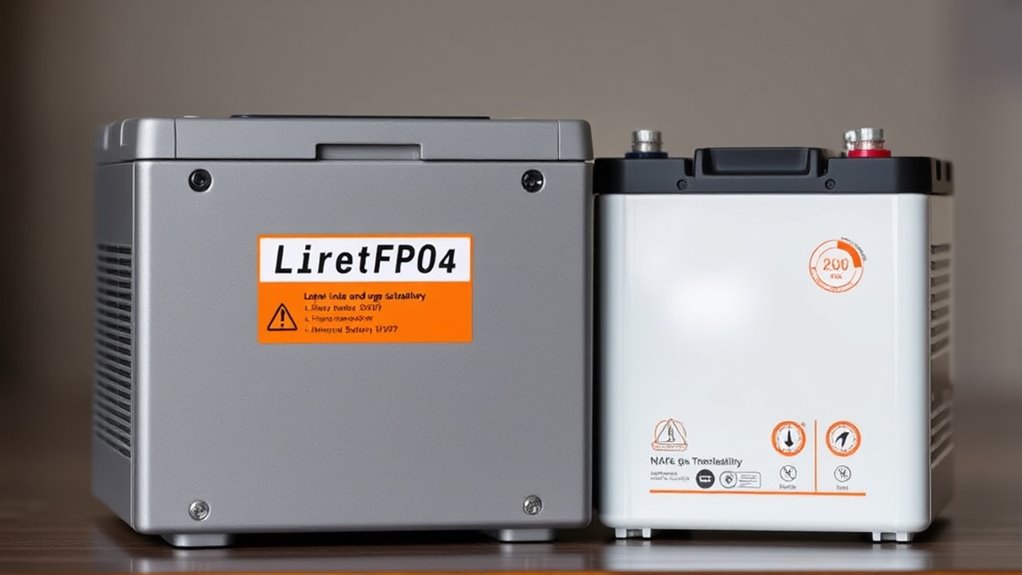
LiFePO₄ batteries are known for their superior safety features and thermal stability compared to other lithium-ion chemistries. This means you’re less likely to face fire risk or thermal runaway, even if the battery is damaged or improperly handled. Unlike some lithium-ion chemistries that can overheat and ignite, LiFePO₄’s chemical structure provides inherent stability, reducing the chances of dangerous failures. You benefit from a safer, more reliable energy source, especially in critical applications like solar generators. The robust thermal stability ensures the battery remains cool and stable during charging and discharging cycles. Environmental considerations also emphasize the importance of choosing safe battery chemistries for sustainable and responsible energy use. With LiFePO₄, you get peace of mind knowing your power system is less prone to catastrophic failures caused by overheating or internal faults.
Performance in Extreme Weather Conditions
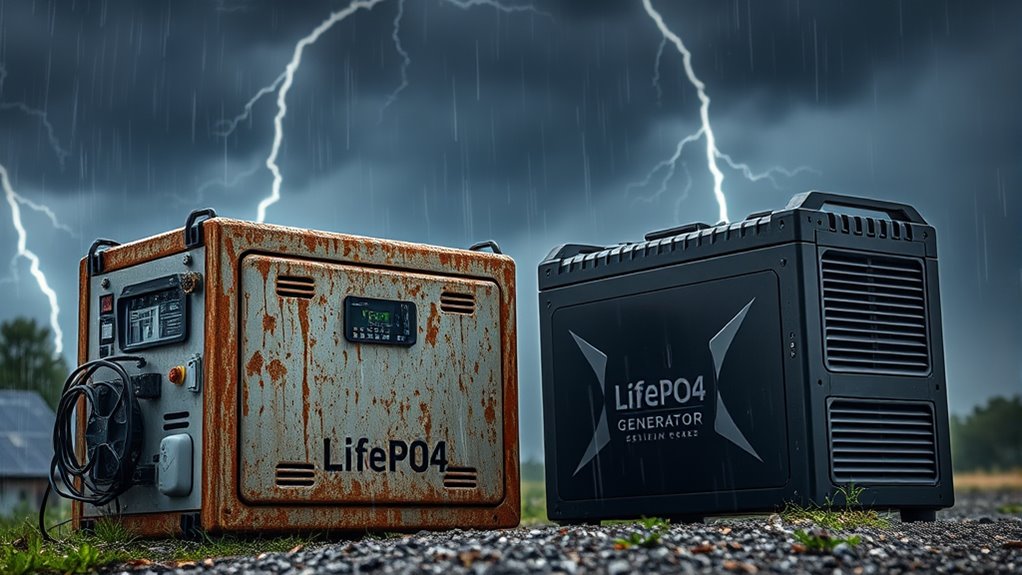
Unlike some other lithium-ion chemistries, LiFePO₄ batteries perform reliably in extreme weather conditions, making them ideal for outdoor and off-grid applications. They excel in temperature resilience, maintaining performance across a wide temperature range, and offer excellent moisture resistance, preventing damage from humidity or water exposure. This durability guarantees your solar generator functions consistently, even in harsh environments. To illustrate, here’s a quick comparison:
| Feature | LiFePO₄ | Typical Lithium-ion |
|---|---|---|
| Temperature Resilience | -20°C to 60°C | -10°C to 45°C |
| Moisture Resistance | High | Moderate |
| Performance Stability | Excellent | Varies |
| Outdoor Suitability | Yes | Limited |
| Durability | Long-lasting | Shorter lifespan |
This resilience makes LiFePO₄ a smart choice for extreme weather conditions. Additionally, its regulatory compliance helps ensure secure and legal use across various regions.
Charging Speed and Efficiency
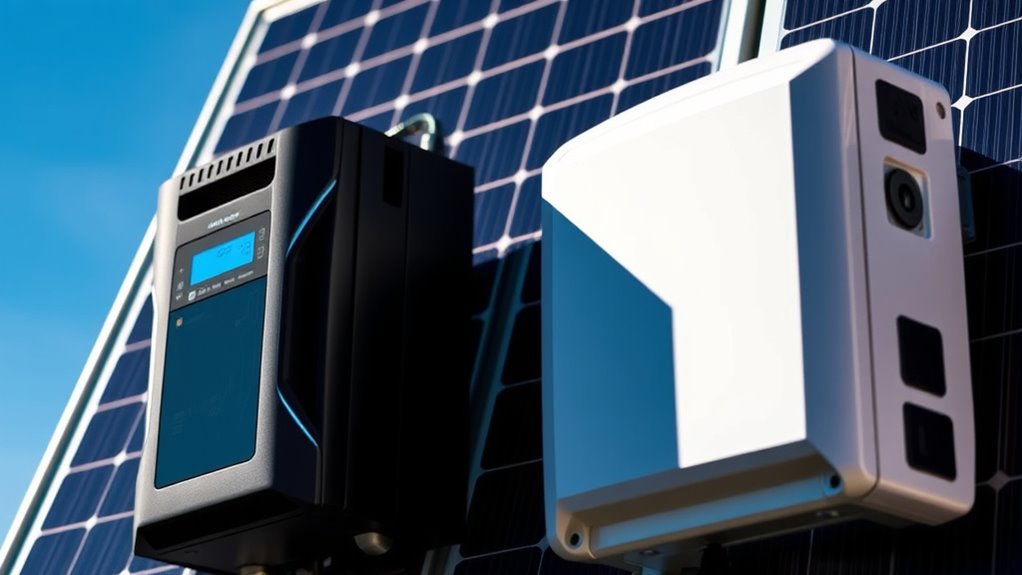
While LiFePO₄ batteries excel in extreme weather resilience, their charging speed and efficiency also play a vital role in their overall performance. You’ll find that LiFePO₄ batteries support faster charging compared to traditional lithium-ion options, thanks to improved energy transfer capabilities. This means you can recharge your solar generator more quickly, minimizing downtime and ensuring your system stays ready when you need it most. The high efficiency of LiFePO₄ batteries reduces energy loss during charge cycles, maximizing the power stored from your solar panels. Additionally, Kia Tuning options like ECU remapping and performance upgrades demonstrate how optimizing energy transfer can significantly enhance overall system efficiency. As a result, you get a more reliable, quicker, and efficient charging process. If fast charging and essential energy transfer are priorities, LiFePO₄ batteries provide a clear advantage over standard lithium-ion alternatives.
Cost Analysis and Long-term Investment
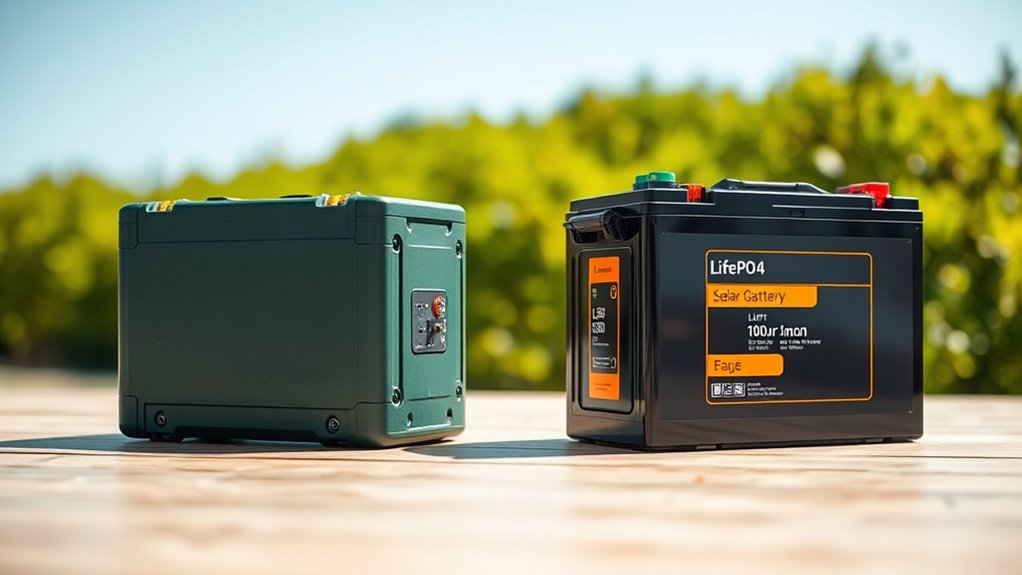
Are you considering the long-term financial benefits of your battery choice? When comparing LiFePO₄ and lithium-ion batteries, cost efficiency plays a vital role. LiFePO₄ batteries often have a higher upfront cost but excel in longevity, reducing replacement expenses over time. They also require less maintenance, saving you money on repairs and replacements. Lithium-ion batteries may seem cheaper initially, but their shorter lifespan and more frequent maintenance needs can add up. Over years, the total cost of ownership favors LiFePO₄, making it a smart long-term investment. By choosing a battery with lower maintenance requirements and better durability, you guarantee more reliable performance and greater savings in the long run. Ultimately, weighing initial costs against long-term benefits helps you make a smarter, financially sound decision. Additionally, understanding the cost implications of different battery types can help you better evaluate your options.
Environmental Impact and Recycling Options
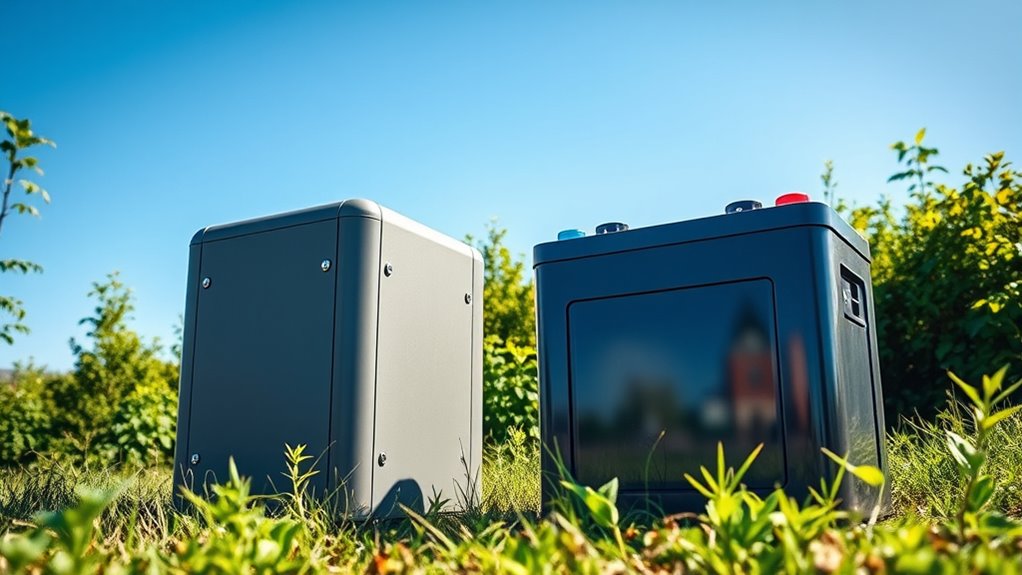
You should consider how recycling lithium-ion batteries can be complicated due to their diverse materials, but doing so offers significant environmental benefits. LiFePO₄ batteries, on the other hand, contain eco-friendly materials that are easier to recycle. Understanding these differences helps you choose batteries that minimize environmental impact throughout their life cycle. Additionally, promoting digital literacy around battery disposal can empower consumers to make more environmentally responsible decisions.
Recycling Challenges and Benefits
Recycling lithium iron phosphate (LiFePO₄) batteries offers notable environmental benefits, but it also presents significant challenges. Proper battery disposal is essential to prevent harmful materials from contaminating the environment. While recycling programs for LiFePO₄ are developing, they’re less widespread than those for traditional lithium-ion batteries, making collection and processing more difficult. Recycling lithium iron phosphate batteries can recover valuable materials like phosphate and lithium, reducing the need for new mining. However, the complex design and safety concerns during disassembly pose hurdles. Despite these challenges, investing in improved recycling technology and expanding collection efforts can help maximize environmental benefits. Exploring the Versatility of Ford Transit Vehicles By properly managing battery disposal, you support a cleaner future and reduce the ecological footprint of solar energy systems.
Eco-Friendly Material Differences
Lithium iron phosphate (LiFePO₄) batteries are often considered more eco-friendly than traditional lithium-ion batteries because they use less harmful materials and have a longer lifespan. Their battery casing is typically made from safer, more sustainable materials that reduce environmental impact. Additionally, the manufacturing processes for LiFePO₄ involve fewer toxic chemicals, resulting in less pollution and waste. This makes them easier to recycle and dispose of responsibly. In contrast, lithium-ion batteries often contain hazardous substances that complicate recycling efforts. By choosing LiFePO₄, you’re supporting a more sustainable option that minimizes environmental harm during production, use, and end-of-life management. Proper battery recycling is essential to mitigating environmental risks associated with battery disposal. Overall, the eco-friendly material differences make LiFePO₄ batteries a smarter choice for a greener future.
Practical Considerations for Solar Generator Use
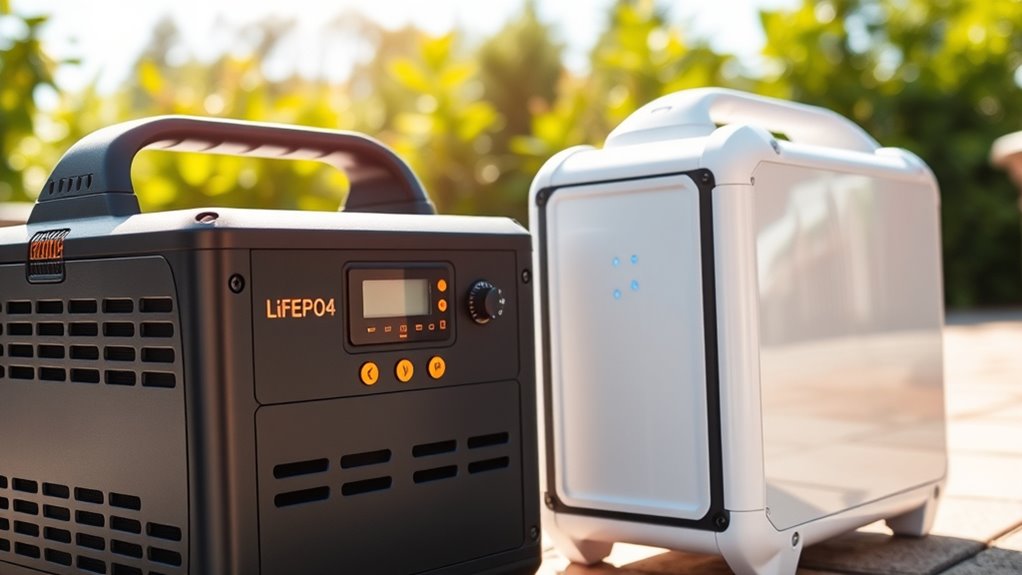
When considering solar generator use, practical factors such as battery type, charging efficiency, and safety protocols play a crucial role in maximizing performance and longevity. To optimize your setup, focus on:
- Regular battery maintenance to prevent capacity loss and guarantee safety.
- Proper storage techniques, like keeping batteries in cool, dry places to prolong lifespan.
- Monitoring charging cycles to avoid overcharging or deep discharges.
- Using compatible chargers to improve efficiency and reduce wear.
- Ensuring your system incorporates efficient heat pump technology to reduce energy consumption and enhance overall system efficiency.
Frequently Asked Questions
How Do Lifepo₄ Batteries Compare in Weight to Lithium-Ion Batteries?
When comparing battery weight, LiFePO₄ batteries tend to be heavier than lithium-ion batteries due to their lower energy density. This means you might carry more weight for the same energy capacity, which could impact portability. However, LiFePO₄’s longer lifespan and safety benefits often outweigh the added weight. If minimizing weight is a priority, lithium-ion batteries might be more suitable, but weigh the trade-offs carefully.
Are There Differences in Warranty Periods Between These Battery Types?
Imagine opening a sturdy, reliable toolbox that promises years of service; that’s what warranty duration offers you. When comparing battery types, LiFePO₄ batteries often come with longer coverage terms, reflecting their durability and resistance to wear. You’ll find that warranty periods for LiFePO₄ tend to be more extensive, giving you peace of mind. Always check the coverage terms, ensuring your investment is protected against unexpected issues over time.
Can Lifepo₄ Batteries Be Used for High-Drain Appliances?
You can definitely use LiFePO₄ batteries for high-drain appliances because they offer excellent high drain performance. They’re known for their superior stability and safety, making them compatible with demanding appliances that require quick bursts of power. Just verify your appliance’s power needs match the battery’s capabilities, and you’ll enjoy reliable, long-lasting performance without worries about overheating or damage.
Do These Batteries Require Special Storage Conditions?
You might wonder if these batteries need special storage conditions. Generally, LiFePO₄ batteries have simple storage requirements; keep them in a cool, dry environment away from direct sunlight and extreme temperatures. Environmental considerations include avoiding moisture and high heat, which can affect performance and lifespan. Proper storage helps maintain their longevity and safety, ensuring your solar generator stays reliable whenever you need it.
How Does Temperature Affect the Lifespan of Each Battery Type?
Temperature critically impacts battery lifespan due to temperature sensitivity. High temperatures accelerate degradation, reducing lifespan, while low temperatures can impair performance. Proper thermal management is essential to maintain ideal conditions, especially in extreme climates. For both battery types, controlling heat exposure helps preserve capacity and prolongs life. You should avoid exposing your batteries to excessive heat or cold, ensuring they stay within recommended temperature ranges for maximum durability.
Conclusion
Choosing between lifepo₄ and lithium-ion batteries depends on what matters most to you. Lifepo₄ offers longer lifespan and safety, making it ideal for long-term use, while lithium-ion provides quicker charging and higher energy density for immediate needs. It’s a trade-off between durability and convenience. Consider your priorities—are you seeking longevity and safety or speed and portability? Your choice impacts not just your solar generator’s performance but also your peace of mind.
